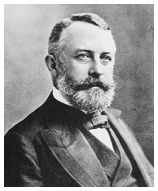

Henry Clay Frick
Born: December 19, 1849
Place: West Overton, Pennsylvania
Died: December 2, 1919
Place: New York City
 Henry Clay Frick was born in West Overton, Pennsylvania on December 19, 1849. West Overton was a rural community some 40 miles southeast of Pittsburgh. As a youth, he worked for his grandfather, a prosperous merchant, as a clerk and bookkeeper. With his earnings and with the availability of family money, Frick saw potential in the abundant bituminous coal deposits in this part of the country. He formed Frick & Co. with several of his associates, purchased coal operations, and began to produce coke from the coal. To produce the coke, coal has to be heated to the point where its gases and tars are removed. Frick and his associates built coke ovens to heat the coal and extract the coke. At this time, Pittsburgh was home to a rapidly expanding steel industry, and coke was an important ingredient in the production of steel. Frick met the demand of the steel industry by acquiring many of the regions coal mines and buying out his competitors. By the age of 30, Henry Frick was a millionaire. His company became the largest producer of coke in the world, operating 12,000 coke ovens and acquiring 40,000 acres of coal.
Henry Clay Frick was born in West Overton, Pennsylvania on December 19, 1849. West Overton was a rural community some 40 miles southeast of Pittsburgh. As a youth, he worked for his grandfather, a prosperous merchant, as a clerk and bookkeeper. With his earnings and with the availability of family money, Frick saw potential in the abundant bituminous coal deposits in this part of the country. He formed Frick & Co. with several of his associates, purchased coal operations, and began to produce coke from the coal. To produce the coke, coal has to be heated to the point where its gases and tars are removed. Frick and his associates built coke ovens to heat the coal and extract the coke. At this time, Pittsburgh was home to a rapidly expanding steel industry, and coke was an important ingredient in the production of steel. Frick met the demand of the steel industry by acquiring many of the regions coal mines and buying out his competitors. By the age of 30, Henry Frick was a millionaire. His company became the largest producer of coke in the world, operating 12,000 coke ovens and acquiring 40,000 acres of coal.
As Henry Frick's control of the coke industry grew, it was perhaps inevitable that he drew the attention of Andrew Carnegie, who had immense investments in the steel industry. Carnegie and Frick entered into a partnership that ensured the future of their dominance in the industry, with Carnegie acquiring an interest in Frick & Co., and Frick obtaining an interest in Carnegie's steel company. In 1889, Carnegie retired from actively managing the steel business, and Henry Frick became chairman of the Carnegie company. In 1892 the steel company was reorganized as Carnegie Steel Company, with Frick as its acting head. The organization was at the time the largest steel company in the world, valued at $25 million. As an aggressive industrialist, Frick always had an eye on profits, and in an attempt to increase his margins, he became known for his heavy-handed dealings with workers and unions in the mills. A labor strike at one of his steel mills, the Homestead Works, grew violent when Henry Frick attempted to bring in 300 strikebreakers to keep the mill functioning. The strikebreakers met strong resistance from the striking workers, and after a day of fighting, 16 people were left dead, and scores more injured. Pennsylvania's governor placed Homestead under martial law to quell the violence, and Henry Clay Frick drew scorn from the public for his strong anti-worker and anti-union stance. The Homestead strike is known as one of the bitterest labor disputes in U.S. history. Shortly after the turbulent strike, Henry Clay Frick was attacked in his office by a man who shot and stabbed him. Frick survived the attack, but it served as a reminder of the violent emotions that surfaced during the labor dispute.
In 1899, Henry Clay Frick left Carnegie Steel, but continued his business interests in cities like Pittsburgh and New York. He played a major part in the formation of U.S. Steel Corporation, and also ventured into railroads and real estate. As an extremely wealthy man, Frick acquired a magnificent collection of art over the years, and when he died in 1919 he left his huge New York mansion and his art collection to the city as a museum. He also donated much of his sizeable fortune, estimated at $50 million, to charitable organizations.
Henry Clay Frick was indeed a controversial figure, a tough businessman in a period of America's history when powerful industrial capitalists built this country's infrastructure. We recommend that you read
Triumphant Capitalism : Henry Clay Frick and the Industrial Transformation of America, by Kenneth Warren. It is a well-researched look at Frick's business career and the development of labor and industrial policy in the steel industry. It is available now through our association with Amazon.com by clicking
here.
For another point of view of Frick's life, we also recommend an elegantly-produced biography of Henry Clay Frick written by his great-granddaughter, Martha Frick Symington Sanger.
Henry Clay Frick : An Intimate Portrait is a huge work, a detailed biography luxuriously produced on heavy stock paper, full of marvelous illustrations and photographs. Highly recommended.
|




